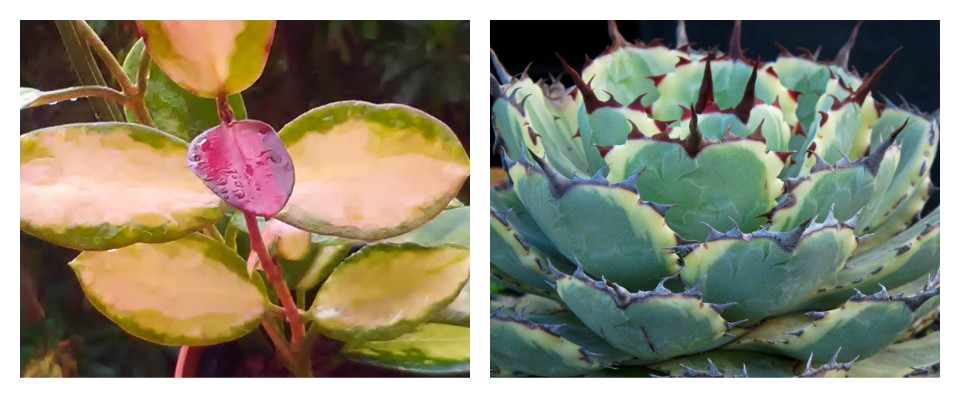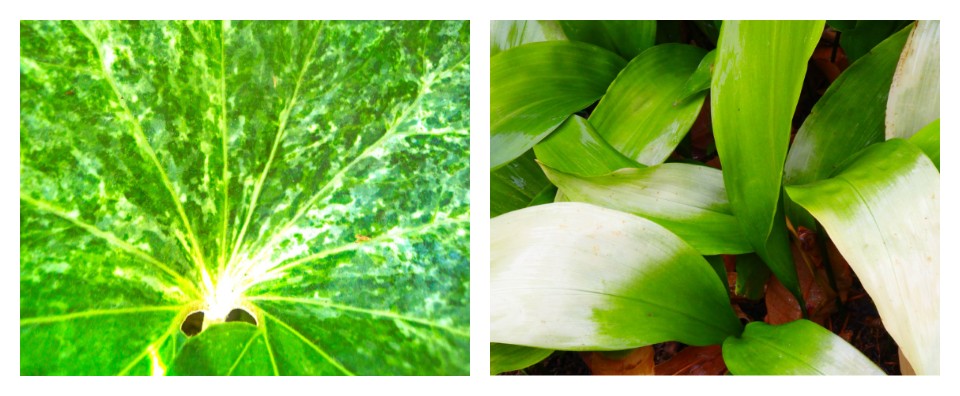Variegation is a phenomenon that naturally occurs in plants as a random event. Variegated plants are visually appealing to people so they have been sought after and reproduced for years in many countries. During the most recent years, variegates have been a success on the international scene, especially with the new cultivars selected in Asia, chiefly in Thailand and Japan. More and more choicy variegates are now reaching Europe and the whole world.
Variegation can show up as stripes or spots or a chequered pattern. Some unusual types of variegation occur when only a part of the leaf is lacking green or when the the whole leaf shows a “frosted” aspect or a spiderweb of white veins. There may be several reasons why variegated plants acquire their originality (chimerism, optical effect, pigment overlap or viral infection). Whatever the reason, this type of plants is very appealing to gardeners.
Different variegated species in different plant families
Almost anything can show variegation. New selections have been developed in bananas to cacti, gingers, palms, aspidistras, ligularias and bromeliads. In Canarius we grow an increasing range of variegated plants to offer.
Some are beautiful, easy, cheap and fast, like the genus Acalypha, that counts in the archipelago with a perfect climate for its growth. Acalypha ‘Hoffmanni’ or Acalypha ‘Macrophylla’ are some of these showy colourful selections, originated in the Pacific islands.
Picture: Acalypha “Hoffanni” / Acalypha “Macrophylla”
At the other extreme we find variegated palms, that are slow to grow and reproduce. The most sought after are the Japanese selections of Rhapis: easy but slow palms, that grow well indoors as house plants. The most valuable variegated Rhapis palms are sold in Japan for 1000’s of Euros as rare bonsai palms! We do grow some Japanese clones here in the Canary Islands!
Variegated Succulents
Agaves, Cacti, Mesembs, Crassulas, Sansevierias and almost all groups of succulents now contain some variegated members. Some variegated succulents grow with good strength, because their white parts are just more storage tissue for the dry season. Agaves are possibly the most beautiful of all, because of their star-shaped symmetry, just like bromeliads. Dwarf, variegated agaves are true gems. Also the genus Hoya deserves a mention. These semi-succulent vines produce waxy, glossy leaves and scented, showy flowers. They tolerate low-light and make good indoor plants.
Pictures: Agave ‘Shoji-Rajin’ and Hoya australis ‘Lisa’
The Giants: Variegated Bananas and Aroids
The largest variegated leaves (after some exceptional palms!) are produced by Musa (bananas) and by the giant aroids of the genera Alocasia and Colocasia. These plants produce enormous leaves quickly, so they are helpful to enhance the tropical-looking garden in cold climates with short summers. Some of them are also edible!
Pictures: These two plants will also produce edible bananas and edible taro corms: Colocasia esculenta ‘Ele Paio Kea’, and Musa x ‘Cavendish ‘Supreme’.
The most loved : Variegated Large Bromeliads
Striped bromeliads are almost hypnotical. Their rosettes occur in all types of shapes and sizes, and the larger the species, the deeper the “hypnosis”! One of the boldest is Aechmea blanchetiana ‘Orange Variegated”, sought after for its exclusivity. Canarius only makes a few of these each year. Striped orange-blanchetianas make a rainbow of colour changing through the seasons.
And, what produces this colour? Just a lower production of the chlorophyll pigment will allow the back-colour of orange, yellow and green to turn into shades of white, pink, and purple: originality and beauty in a single plant.
Are Variegates Difficult and Expensive?
Not all of them! Most variegated plants are just a bit slower than their green counterparts, because they have less chlorophyll. Nevertheless, some variegates are more finicky. Some of them burn their tips or white parts in adverse conditions (dry, wind, cold, salt, etc.) so it is better to keep them a bit more sheltered than the other plants that you grow.
But, yes! Some variegated selections are doubtlessly more expensive. Not necessarily because they are slow or difficult, but chiefly because they are hard to reproduce, for these two reasons:
-
Most variegated plants do not grow true from seed. Most or all their seedlings will be green, so they need to be reproduced by cutting or other similar ways.
-
Some variegates give too many fully-green or fully-white shoots and only a few branches with the right proportion of green and white.
An example of slowness and patience is Aspidistra ‘Asahi’: This is a variegated for connoisseurs. Its new leaves are all green but the following year their upper part turns deep white. So it takes some time to develop the desired effect. Also the unusual Farfugium ‘Kaimon Dake’ takes some time to develop its white “frosted” leaves.
Pictures: Some different, slower Japanese variegates: Aspidistra ‘Asahi’ and Farfugium ‘Kaimon Dake’
What do we grow and what do we do ?
Since 2004, we imported variegated plants from all parts of the world, with the goal of building up our stock of mother plants. We also search for new variegations appearing randomly from green plants, both in our nursery and in other nurseries of the Canary Islands.
Our team is working on more and more new variegates for the future, from fruit trees to gingers and succulents. Canarius grows all here in Tenerife, with quality and respect for the ecosystem.





















